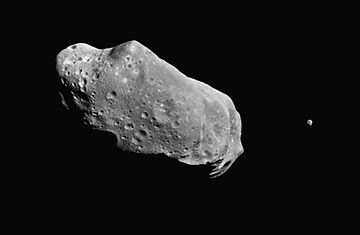
Nobody saw the asteroid coming as it closed in on central Russia on the morning of June 30, 1908. No one knows exactly how big it was either. There was no mistaking, however, the wallop it packed. A few miles above the forested area surrounding the Tunguska River, the asteroid exploded in an air burst that released an estimated 30 megatons of destructive energy — about 1,000 times greater than that of the atomic bomb that destroyed Hiroshima — flattening 80 million trees and devastating more than 830 sq. mi. (2,150 sq km) of landscape.
It was, on the whole, a very bad day — and yet it's a day that could have been far, far worse. A similar air burst over a major city could have killed millions.
That's the kind of scenario that keeps sky watchers and public-safety officials around the world up at nights — and with more reason than most people realize. Astronomers have estimated that there are about 35,000 midsize, near-Earth asteroids flying around out there — midsize meaning 330 ft. to 3,300 ft. (100 m to 1,000 m), and near-Earth meaning within 120 million mi. (195 million km). For larger asteroids, the guess has been about 1,000 in the near-Earth hot zone.
In 1998, the U.S. Congress charged NASA with the responsibility of taking a more accurate count of the space rubble, determining the number and at least the general location of 90% or more of the dangerous rocks in our patch of space. On Sept. 29, the Jet Propulsion Laboratory in Pasadena, Calif., announced that it had achieved that goal and that the results were reassuring — sort of. The total of likely midsize asteroids that could threaten Earth has been reduced considerably, from 35,000 to 19,500. The likely population of the large ones has been tweaked a little, from 1,000 to 981. With better knowledge, the scientists and lawmakers hope, could come better preparedness.
NASA took its asteroid head count with the help of the Wide-field Infrared Survey Explorer (WISE), a spacecraft launched into Earth orbit in 2009. As its name implies, WISE scans the skies in the infrared spectrum rather than the visible, which is good for spotting cool, dim stars and also, in this case, for spotting asteroids that may be too dark or nonreflective to be detected visually. In something of an orgy of acronyms, the asteroid study was dubbed NEOWISE, for Near-Earth Object Wide-field Infrared ... you get the rest.
Conducted from January 2010 to February 2011, NEOWISE scanned the entire bowl of the sky twice, and while the tally of dangerous objects it found steadily mounted, it did not technically detect and pinpoint all of them — nor was it supposed to. Instead, the astronomers relied on a sampling technique similar to the one census takers use, surveying a representative slice of all of the people living in a region and then extrapolating what the total is. Despite the political kerfuffle that is kicked up whenever sampling is discussed as a way to count Americans, the technique works both for people and for asteroids. "NEOWISE allowed us to take a look at a more representative slice of the near-Earth asteroid numbers and make better estimates about the whole population," said Amy Mainzer, principal investigator for the project.
Certainly, the share of asteroids actually found, as opposed to statistically inferred, was not peanuts: 5,200 of the estimated 19,500 in the midsize category are now logged and fully trackable, as well as 911 of the 981 jumbo rocks. Earthbound astronomers continue to look for the remaining ones in both categories, and NASA is optimistic they will find more. "The NEOWISE ... results complement ground-based observer efforts over the past 12 years," said Lindley Johnson, who heads the agency's near-Earth-object observation program. "These observers continue to track these objects."
Even after every near-Earth object is seen and cataloged, the problem is what you do if one looks like it's heading your way, set to arrive in, say, five years' time. Here, the options are as numerous as they are unproven. You could send a spacecraft to intercept the object and blow it up — provided you can sell the public on the wisdom of launching a rocket loaded with conventional or nuclear ordnance and provided you don't just create a bunch of slightly smaller rocks that could hit the planet like a cluster bomb.
You could, in the alternative, use a gentler blast to knock the asteroid off course or even attach a rocket to it to push it onto another trajectory. NASA's recent rendezvous with asteroids — for the purpose of studying them, not destroying them — have proved that we've got the navigational smarts and deft flying skills to pull off such a maneuver. But that doesn't mean it would be easy. If one of the recent missions had flown wide of the mark, all that would have been lost would be data; if an intercept mission fails, you could lose the planet.
Neither the new survey nor the intercept ideas take into consideration the 1 million or so small asteroids that also swirl in near-Earth space — none of which could do global damage, but most of which could make for a very big mess. That's probably wise. If the astronomers need any further motivation to keep their attention focused squarely on the deadliest potential projectiles, they need only look 65 million years back in history, when an asteroid in the large category struck the earth, sending up a cloud that darkened and cooled the planet and wiped out the dinosaurs in the process. Smart mammals have a better chance of protecting themselves from such a calamity than dumb lizards did — and the latest survey is an important step in that direction.
